Has Subcategory 9.5 of the Listed Activities Really Been Set Aside?
(Sawmilling South Africa vs Department of Environmental Affairs, in the High Court)
The picture above of the Blue Ridge Mountains in Virginia is both evocative and calming, as the smoky blue haze covers the mountains like blankets. But where does this haze come from? What purpose does it serve? And what does all this have to do with subcategory 9.5 of South Africa’s Air Quality Listed Activities?
The Blue Ridge mountains are named for their beautiful blue haze, resulting from the way that tiny aerosols diffract short wavelength sunlight. These aerosols are released by the forests and are comprised of naturally-occurring organic chemicals such as monoterpenes, like α- and β- pinene, which give pine wood its characteristic smell. Plants emit terpenes to protect their leaves from heat. Terpenes are also the primary constituents of essential oils, like the lavender and eucalyptus oils that one puts in one’s bath.
When wood is dried in indirectly-fired kilns, the only emissions are these naturally-occurring terpenes and the moisture that is driven off the wood as it is dried. Wood drying kilns in South Africa are heated with steam and are called “indirectly-fired” because the heat is not generated in the kiln itself but rather in a boiler. The energy is transferred from the boiler to the kiln using steam as the medium. This is depicted in the diagram beneath. The boiler is shown in the middle, the kiln is shown on the left, and the treatment of the boiler’s flue gases are shown on the right:
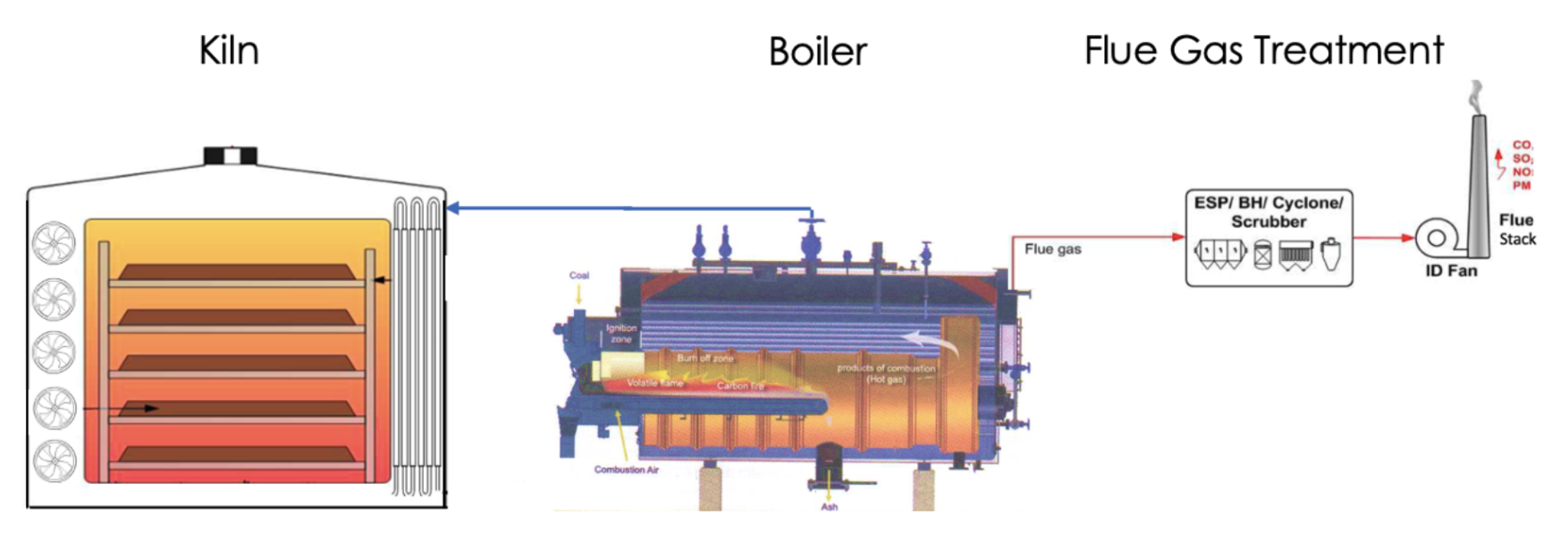
Figure 1: Indirectly-Fired Kiln, Boiler and Abatement Equipment
Inside the kiln, the steam flows through a heat exchanger, imparting its heat to the internal air, which is circulated by fans to dry the wood. To control the relative humidity, a small amount of live steam may be injected into the kiln.
Indirectly-fired kilns that use steam, like those found in South Africa, are widely used around the globe. However, in countries where gaseous fuels (such as LPG, LNG, and CNG) are affordable, directly-fired kilns are sometimes used. They are uncommon in South Africa. Direct drying is used in applications where discolouration of the wood due to the combustion flue gases is inconsequential. When direct firing, the combustion flue gases are blended with cool air to obtain the required temperature for optimal wood drying. A directly-fired kiln is shown in the diagram beneath:
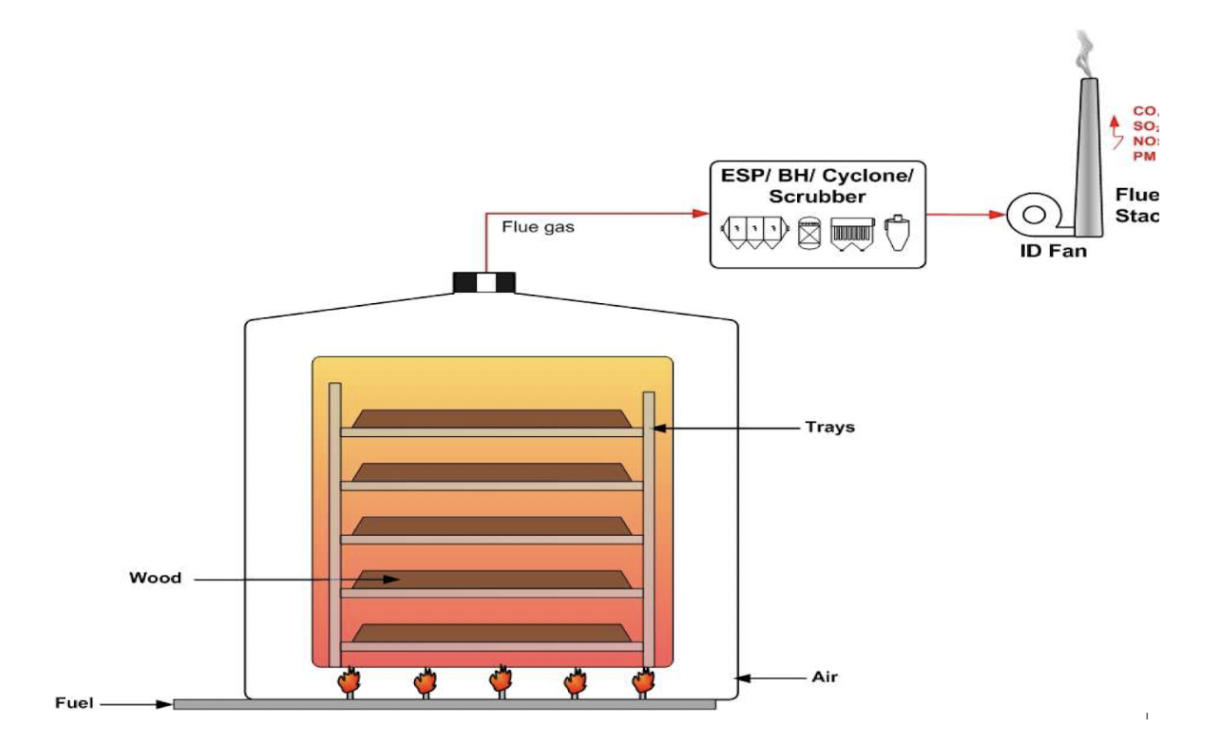
Figure 2: Directly-Fired Kiln
When a kiln is fired directly, the flue gases must be treated by appropriate air pollution abatement equipment, if required. If the direct firing creates particulate matter, then a multi-cyclone, bag filter or electrostatic precipitator may be necessary. This is why, in the diagram above, abatement equipment is shown as attached to the kiln.
The diagram above is from the South African Listed Activities companion notes. These companion notes are beneficial in understanding the intention of the Listed Activities legislation. This diagram shows that the legislation intended to regulate emissions from directly-fired kilns and not indirectly-fired kilns. Because indirectly-fired kilns do not produce combustion emissions [such as particulate matter (PM), sulphur dioxide (SO2) and the oxides of nitrogen (NOx)], there is no need to regulate these kilns. Their only emissions are naturally-occurring terpenes and water vapour.
For this reason, Sawmilling SA brought a case against the Department of Environmental Affairs (DEA), which is now known as the Department of Forestry, Fisheries and the Environment (DFFE), seeking an order that the inclusion of indirectly-fired kilns in subcategory 9.5 be set aside insofar as it requires:
“A sawmill that dries wood in an indirectly-fired kiln with an external source of heat in the form of a boiler with a design capacity ≤ 50 MW to obtain an Atmospheric Emissions License (AEL).”
It is critically important to note that SA Sawmilling did not ask for the whole of subcategory 9.5 to be set aside for all activities that subcategory 9.5 regulates. SA Sawmilling asked only that it be set aside for sawmills that operate indirectly-fired kilns using boilers with a rating of 50 MW or less of Net Heat Input (NHI). In February 2021, the Gauteng High Court found in favour of SA Sawmilling and against the DEA:
“The Minister’s decision to publish the listed activity in subcategory 9.5 of the 2018 regulations is reviewed and set aside.”
While the focus of the judgment was on indirectly-fired kilns, strangely, the order does imply that the whole of subcategory 9.5 has been set aside. We question whether this was an error. Interestingly, the DFFE have chosen to interpret the judgement in light of the original application, stating that it pertains only to indirectly-fired kilns, and we agree. The DFFE make this clear in a directive regarding the licensing of sawmills (see text that is highlighted in yellow):
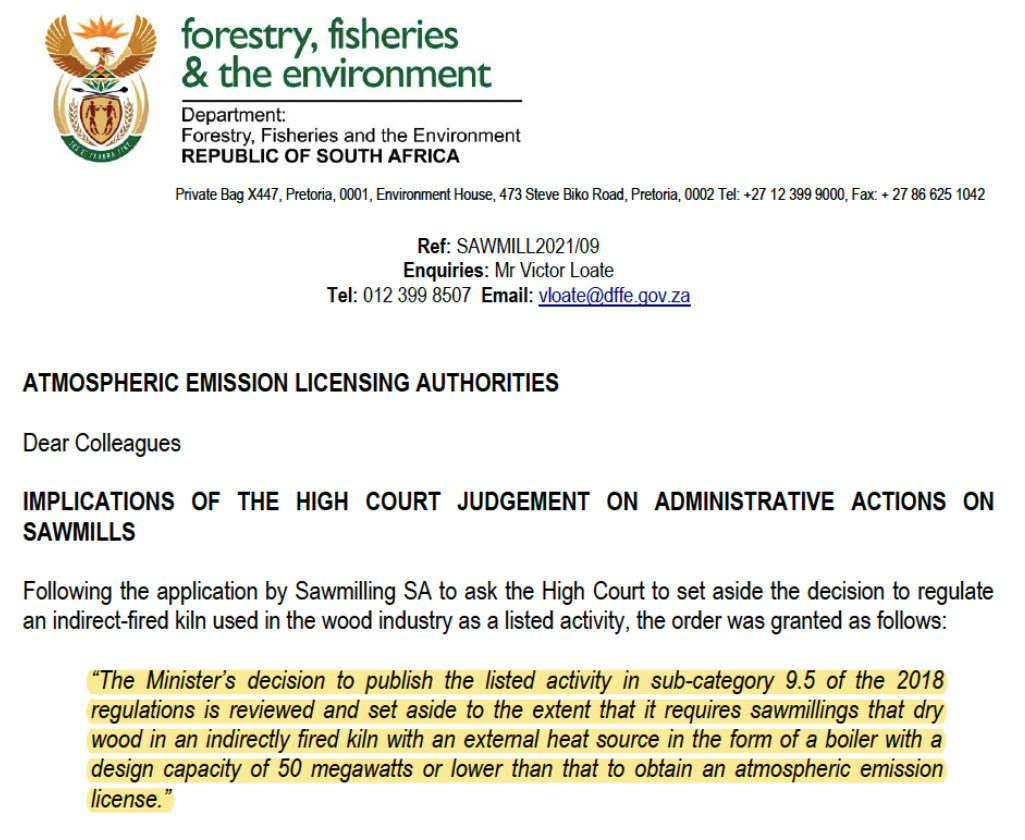
Let’s delve into the history behind this story.
In 2004 the National Environmental Management: Air Quality Act (NEM:AQA) was promulgated. Section 21(1) of NEM:AQA stated that the Minister of Environmental Affairs and Tourism (as the department was known at that time) must publish a list of activities that significantly affect the environment. In 2010 the Minister published the first list of Listed Activities and in 2013, this list was revised and republished in GN 893. Several amendments have subsequently been made to the 2013 list. Most notable for the timber industry are the amendments that were made in October 2018. Before October 2018, subcategory 9.5 in the Listed Activities read as follows:
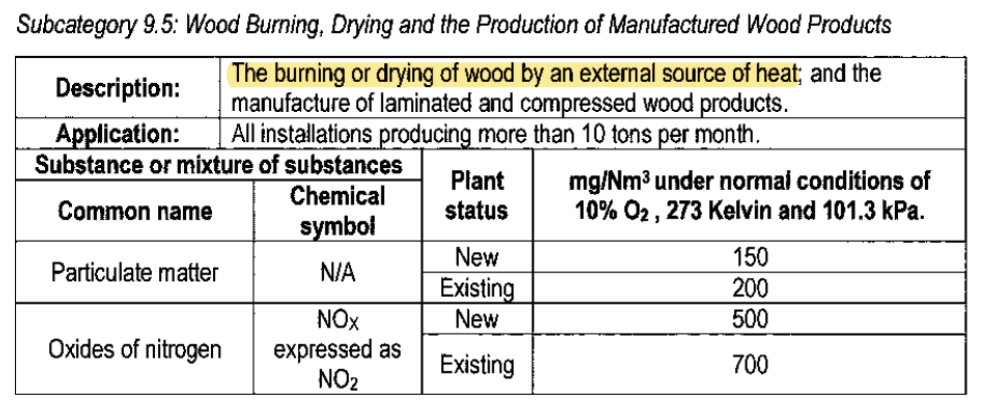
As highlighted in yellow above, sawmills triggered subcategory 9.5 in two ways: they were burning wood in their boilers and drying wood by an external heat source.
This was confusing because boiler emissions were subsequently also regulated under the controlled emitters legislation, GN 831 of 2013. This meant that some boilers were regulated under two pieces of legislation and therefore had two sets of emissions limits: those imposed by subcategory 9.5 and those imposed by the Controlled Emitters legislation (GN 831). However, on the 31st of October 2018, subcategory 9.5 was amended to eliminate the confusion, as shown below. Underlined text indicates text that was added to the old legislation:
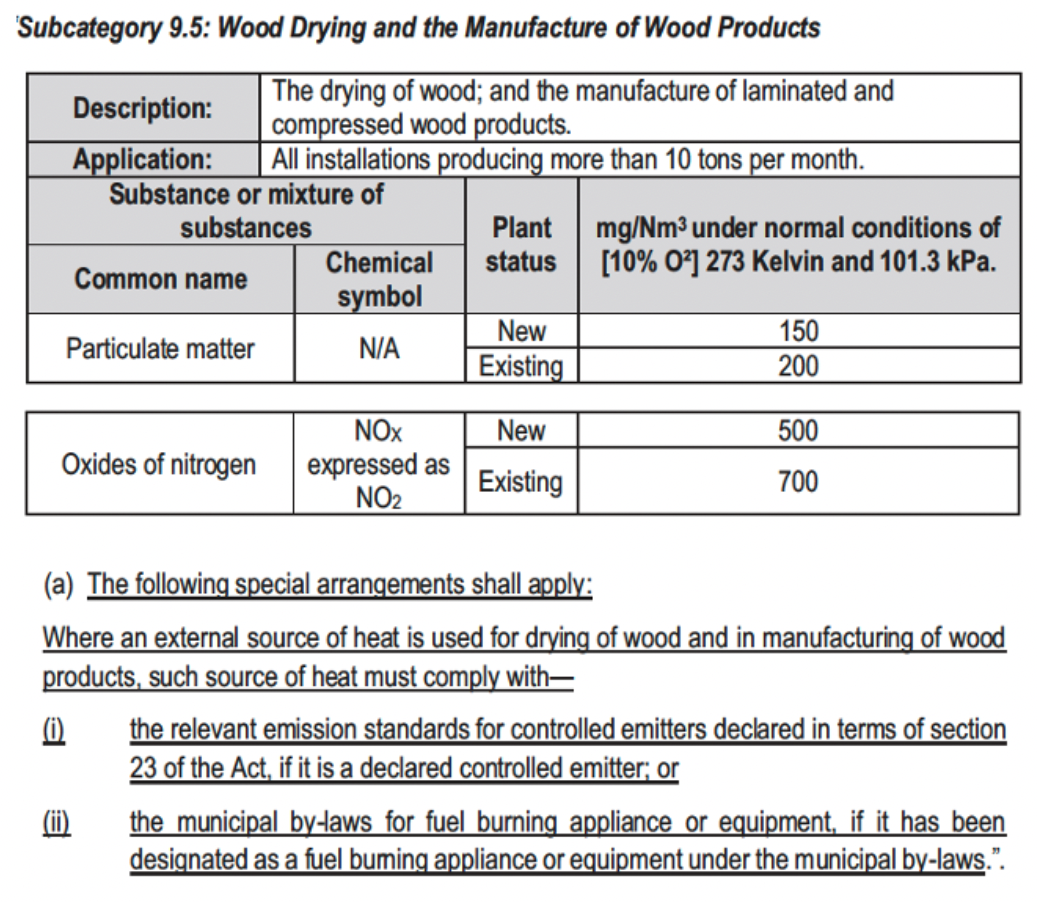
Furthermore, as you will see in the excerpts above, a “special arrangement” was introduced that states that external sources of heat (i.e. boilers) are no longer required to comply with the subcategory 9.5 emissions limits and are instead required to comply with the emissions limits for Controlled Emitters (if the boiler has an NHI of 10 – 50 MW). These were two welcome changes to the legislation.
However, one problem was exacerbated by the 2018 legislation. The term “by an external source of heat” was removed, meaning that the term ”drying of wood” was more widely applicable than before. Peculiarly, the Minister had notified industry on the 25th of May 2018 in GN R516 that he intended to do the very opposite of this. The minister had proposed the new wording to read:
“Description: the drying of wood using direct-fired kilns, and the manufacture of laminated and compressed wood products.”
But this proposed wording was not enacted into legislation. If it had been passed, it would have deregulated all indirectly-fired kilns as they emit only terpenes and water vapour. SA Sawmilling would have been satisfied with this wording and would not have needed to take the DEA to court. The court upheld the view that indirectly-fired kilns do not create environmental damage and handed down a judgment ordering that:
“The Minister’s decision to publish the listed activity in subcategory 9.5 of the 2018 regulations is reviewed and set aside.”
The DFFE is appealing this judgment at the Supreme Court.
While the focus of the judgment was on indirectly-fired kilns, the order does implicate that the whole of subcategory 9.5 has been set aside. However, the DFFE clarified in a letter (which can be downloaded beneath) that they believe that the judgement applies only to:
“A sawmill that dries wood in an indirectly-fired kiln with an external source of heat in the form of a boiler with a design capacity ≤ 50 MW to obtain an Atmospheric Emissions License (AEL).”
Yellow Tree’s Opinion:
1. It is Yellow Tree’s professional opinion, based on research, that indirectly-fired kilns:
a) produce no combustion-related pollutants (PM, SO2 or NOx),
b) produce mostly water vapour (which is not harmful) and terpenes (which are naturally occurring),
c) cause no environmental harm.
2. Therefore, we believe that there is no benefit to be derived from licensing indirectly-fired kilns using Atmospheric Emissions Licences (AELs).
3. To confirm the facts above, Yellow Tree is prepared to sample the vent of an indirectly-fired kiln as an independent third party, should the DFFE, SA Sawmilling, or the Supreme Court of Appeals find this beneficial. Yellow Tree will gladly do so free of charge to serve the environment.
4. Both the DFFE who promulgate the environmental legislation, and the municipal and provincial authorities that implement it, have an enormous task ahead of them in their admirable goal of improving air quality in South Africa. We share this goal at Yellow Tree as the environment is dear to our hearts. By deregulating indirectly-fired kilns that produce no pollution, the DFFE and local authorities are freed up to focus on regulating South Africa’s main polluters such as coal-fired electricity generation, small boiler operation (firing coal and heavy furnace oil [HFO]), cement production, the petroleum industry, waste incinerators, and the pulp and paper industry, to name but a few. Therefore, this judgement by the High Court unlocks great benefit for Air Quality in South Africa by permitting the DFFE and local authorities to focus their scarce resources on the most significant environmental victories.
5. The High Court should not have set aside the whole of subcategory 9.5. As the DFFE rightly stated, subcategory 9.5 should only have been set aside insofar as it:
a) pertains to a sawmill…
b) that dries wood in an indirectly-fired kiln…
c) with an external source of heat in the form of a boiler…
d) with a design capacity ≤ 50 MW…
e) requiring an Atmospheric Emissions License (AEL).
6. Sawmills will still be regulated under the National Environmental Management Act (NEMA) and may trigger Environmental Impact Assessments (EIAs). Therefore, their environmental impact will still be managed, which may allay concerns of the DFFE that sawmills will go unregulated. Only the air quality impact pertaining to kilns ought to be deregulated.
7. Should the DFFE feel that sawdust from sawmills poses a fugitive emissions problem, and would like sawmills to be licensed with Atmospheric Emissions Licenses (AELs), then the Listed Activities legislation should be adjusted to deal specifically with fugitive sawdust. The sawmilling component of an operation is entirely separate from the drying of wood in kilns and, as such, should be dealt with separately and appropriately.
8. Yellow Tree recommends that other activities that have historically been regulated under subcategory 9.5 (such as the manufacture of laminated and compressed wood products) continue with their duty of stack sampling in good faith; and that local and provincial municipalities continue to license these activities, as encouraged by the DFFE. It was not the intention of the High Court to set aside subcategory 9.5 in its entirety because this was not the application that SA Sawmilling sought. Interestingly, two municipalities with which Yellow Tree engages, are not processing any subcategory 9.5 AEL applications, even if the facility does not have indirectly-fired kilns (e.g. particleboard and MDF production facilities). We would encourage all municipalities to proceed as per the DFFE’s written directive (attached beneath) and to license subcategory 9.5 listed activities except those with indirectly-fired kilns.
9. The DFFE may do well to consider regulating boilers that are smaller than 10 MW NHI. The most common size of boilers in South Africa is 7.3 MW NHI. These boilers are known in industry as “10 t/hr boilers" (from and at 100ºC) and are often installed in groups of two to five. 10 t/hr boilers are usually chosen over larger boilers, because having several present at a factory introduces operational redundancy. Furthermore, 10 t/hr boilers represent a cost-effective method of side-stepping the controlled emitters legislation, therefore avoiding the costly installation of suitable abatement equipment (e.g. bag filters). Yellow Tree recommends that the DFFE engage with South Africa’s only boiler fabricator, John Thompson, to determine the size of boiler most commonly sold over the past 40 years (which is most likely the 10 t/hr boiler) and to ensure that these boilers are regulated. Cumulatively these boilers comprise a significant source of absolute emissions, and many emit excessively high concentrations of PM.
10. Yellow Tree recommends that subcategory 9.5 of the legislation be reworded as the DFFE originally suggested: the drying of wood using direct-fired kilns, and the manufacture of laminated and compressed wood products. This is in accordance with the original intention of the legislation, as noted in the companion notes of 2010.
11. The court did a commendable job obtaining the opinion of Dr Ströhr, who indicated that indirectly-fired kilns are not a source of air pollution. Additionally, the High Court’s judgement has freed up the DFFE and South African Air Quality Officers to focus on regulating sources of pollution that have an immense detrimental impact on the environment by avoiding focusing on those that do not.
12. We believe that all stakeholders will benefit from engaging in good faith while remaining unified in improving air quality and serving the environment.
Amendment: As per the following attachment, the high court have indeed confimed that Subcategory 9.5 is only set aside in so far as it:
a) pertains to a sawmill…
b) that dries wood in an indirectly-fired kiln…
c) with an external source of heat in the form of a boiler…
d) with a design capacity ≤ 50 MW…
e) requiring an Atmospheric Emissions License (AEL).
